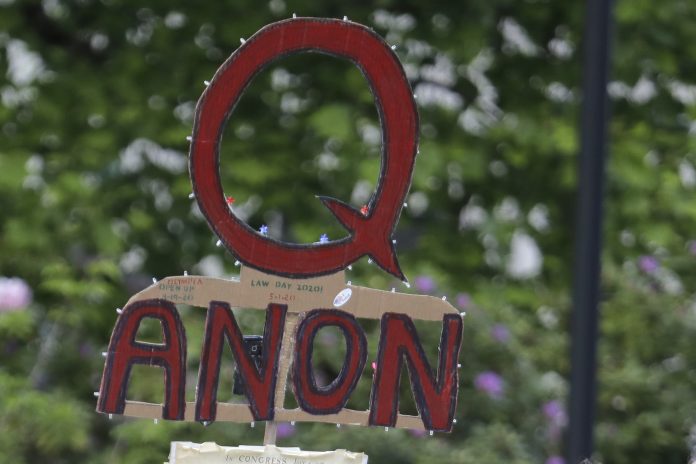
By MICHAEL KUNZELMAN
Associated Press
Newer strains of far-right movements fueled by conspiracy theories, misogyny and anti-vaccine proponents contributed to a modest rise in killings by domestic extremists in the United States last year, according to a report released Tuesday by a Jewish civil rights group.
Killings by domestic extremists increased from 23 in 2020 to at least 29 last year, with right-wing extremists killing 26 of those people in 2021, the Anti-Defamation League said in a report first provided to The Associated Press.
The ADL’s report says white supremacists, antigovernment sovereign citizens and other adherents of long-standing movements were responsible for most of the 19 deadly attacks it counted in 2021. The New York City-based organization’s list also included killings linked to newer right-wing movements that spread online during the coronavirus pandemic and former President Donald Trump’s presidency.
The ADL concluded that roughly half of the 2021 killings didn’t have a clear ideological motive, fitting a pattern that stretches back at least a decade.
The group’s tally included a shooting rampage in Denver by Lyndon James McLeod, who killed five people in December before a police officer fatally shot him. McLeod was involved in the “manosphere,” a toxic masculinity subculture, and harbored revenge fantasies against most of his victims, the ADL report notes.
Right-wing conspiracy theorists killed five people last year in two incidents, both involving “troubled perpetrators,” the ADL report says.
In August, California surfing school owner Matthew Taylor Coleman was charged with killing his two young children with a spear gun in Mexico. Coleman told an FBI agent that he was “enlightened” by conspiracy theories, including QAnon, and believed his wife had passed “serpent DNA” on to his children, according to a court affidavit.
A Maryland man, Jeffrey Allen Burnham, was charged with killing his brother, his sister-in-law and a family friend in September. Charging documents said Burnham confronted his brother, a pharmacist, because he believed he was poisoning people with COVID-19 vaccines.
“Prior to the coronavirus, the anti-vaccine movement in the United States did not have a particular ideological leaning and contained both left-leaning and right-leaning activists,” the ADL report says. “However, the politicization of the coronavirus and other factors have created many new anti-vaccine conspiracy adherents and given the anti-vaccine movement a distinctly right-wing tone it did not previously have.”
The QAnon conspiracy theory has been linked to other acts of real-world violence, including last year’s riot at the U.S. Capitol. In June, a federal intelligence report warned that QAnon adherents could target Democrats and other political opponents for more violence.
A core idea QAnon promotes is that Trump was secretly fighting a Satan-worshipping, child sex trafficking cabal of “deep state” enemies, prominent Democrats and Hollywood elites. QAnon hasn’t faded away with Trump leaving office.
Mark Pitcavage, a senior research fellow at the ADL’s Center on Extremism and author of Tuesday’s report, said the QAnon movement is still evolving and increasingly overlapping with other extremist movements, including vaccine opponents.
“Could it sort of dissipate into those or could it find some sort of new focus or new life? Or could it just hang around if Donald Trump is elected again in 2024 and take a new form then?” Pitcavage said during an interview. “It’s difficult to predict the future of those movements, so it’s difficult to predict whether they will continue to have this sort of similar effect on people.”
A dearth of mass killings in 2021 meant that last year’s tally was far lower than the totals in any year between 2015 and 2019, when killings by domestic extremists ranged from 45 to 78.
In other respects, the ADL data for 2021 mirrors long-term trends.
Right-wing extremists have killed at least 333 people in the U.S. over the past decade, accounting for three-quarters of all extremist-related killings, the report says.
The ADL distinguishes between killings that it considers to be driven by ideology and those that it found to be non-ideological or lacking a clear motive. Its report says the numbers for each category have been close to even over the past 10 years. The ADL concluded that 14 of the 29 extremist killings in 2021 were apparently motivated at least in part by ideology.
The ADL attributed 13 killings last year to white supremacists, three to anti-government extremists, two to Black nationalists and one to an Islamist extremist.
The group didn’t count the death of Capitol Police officer Brian Sicknick during the Capitol riot on Jan. 6, 2021, as an extremist killing. Sicknick collapsed and died hours after he was attacked by rioters who stormed the Capitol and interfered with Congress’ certification of President Joe Biden’s electoral victory. In April, the Washington, D.C., medical examiner’s office ruled that Sicknick suffered a stroke and died from natural causes.
“Although it is clear that the Capitol attack could have contributed to, or even precipitated, the strokes that felled Sicknick, it cannot be definitely proven that he was murdered by a Capitol stormer,” the ADL report says.



















